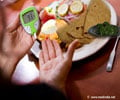Diabetes affects people of all ages, everywhere in the world. Unless the condition gets worse, diabetes can be controlled through appropriate diet, medication and tailored fitness routine. Fitness expert Dr. Selvapandian of Metabolic Fitness Hub, Chennai, India, speaks to Medindia on the fitness regimen targeting people with diabetes.
Recommended Exercises:Weight training is recommended for people with diabetes to improve their High-Density Lipoprotein (HDL) and reduce their Low-Density Lipoprotein (LDL). HDL is ‘Good Fat’ and LDL is ‘Unwanted Fat’, hence the focus of the exercises is to burn unwanted fat. Following are some of the workouts suggested:
• Adopt training with moderate weights. If the weights are too heavy move to levels of lesser weights.
• Exercises with low weights can be done with increased repetitions*, for example, 2 to 3 sets* with 12 to 20 repetitions at a minimum weight of 40 to 60% of 1 RM (one repetition for maximum) *.
• Spend 30 minutes each day on weight training exercises.
• Use 30 minutes each day on Cardio exercises.
• Take regular intervals between workouts.
• Walking is ideal. Walk briskly for at least 30 minutes everyday.
Exercises to be avoided:
People choose appropriate clothes and accessories to look their best and avoid certain colors and textures that may look good on another person but not necessarily for them. Similarly one’s effort to stay in good health also calls for the use of discretion while exercising. In order to keep oneself in the best of health, certain exercises and practices are best avoided for people with diabetes.
• Exercises must be avoided on an empty stomach. People with diabetes are under medication. Hence the sugar level in the blood tends to be low. If a person with diabetes exercises on an empty stomach, the sugar level will drop lower, leading to fatigue and a person may even faint.
• Steer off heavy weight training.
• Avoid physical activities that extend beyond one hour. Workout session should be limited to maximum one hour.
• Stay away from elliptical trainer or cross-trainer (EFX) machines.
• Avoid exercises that require holding one’s breath. Exercises should ensure blood pressure is properly maintained.
* 1 RM is one repetition maximum. It is the maximum weight a person can operate one time when doing a particular exercise. If a particular exercise has to be done 5 times continuously, it is called a ‘Repetition’. So, ‘1 Set’ is the particular exercise done 5 times continuously (repetitions) according to this example. If a person has to do 3 Sets of this exercise, the person will do 1 Set (first 5 repetitions) will then take a break; do the 2nd Set (second 5 repetitions) will then take a break and continue with the 3rd Set (final 5 repetitions). At the end of the particular training the person would have done 15 repetitions with 2 intervals. The repetitions may vary, increase or decrease, from one workout to another depending on the person’s physical and mental state.
In many cases diabetes is unavoidable but before the condition worsens, complications can be averted with healthy habits. So when a person is diagnosed with diabetes, with due care of body and mind, diabetes can be kept under check. Fitness is among the vital necessities and ensures a person gets healthy and stays healthy despite the onset of diabetes.
Source-Medindia















